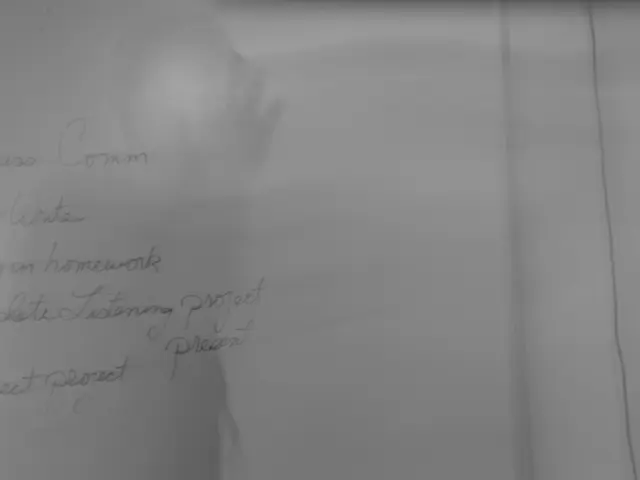If satellite destruction seems unnecessary, perhaps satellite hacking could be a more viable option?
In a groundbreaking demonstration at Black Hat 2025, Milenko Starcik and Andrzej Olchawa from VisionSpace Technologies revealed multiple critical flaws in widely used open-source satellite management systems, highlighting the urgent need for security improvements in these essential tools for satellite command and control [1][2].
The researchers found five separate Common Vulnerabilities and Exposures (CVEs) in the code of Yamcs, an open-source application used by NASA and Airbus for satellite communication and control. These vulnerabilities could potentially allow attackers to hijack the control system and alter a satellite’s trajectory without immediate detection [1].
Another open-source ground control application, OpenC3 Cosmos, was found to have seven CVEs. These include remote code execution and cross-site scripting vulnerabilities, which could enable infiltration or manipulation of satellite command-and-control systems [1].
CryptoLib, an open-source, C-based encryption library used by many satellites, was also identified as having four flaws in its version and seven in the standard package, two of them rated as critical [2].
NASA’s Core Flight System (cFS) Aquila was not left untouched, as it was found to have several critical vulnerabilities such as denial-of-service, path-traversal, and remote code execution bugs that could crash flight software and provide full code execution access to attackers [1].
The potential risks associated with these open-source satellite management systems are significant. They include unauthorized command execution, remote code execution leading to takeover of ground or onboard systems, denial-of-service attacks, credential leaks, cross-site scripting attacks affecting ground control consoles, and stealthy manipulation with delayed or obfuscated telemetry to mask malicious actions [1][2].
These revelations underscore the fact that even highly trusted space agencies and companies rely on software with exploitable flaws, indicating a broader issue of insufficient security auditing and hardening within the satellite operations ecosystem [1][2].
As the number of functioning satellites in orbit continues to rise—currently approximated at 12,300 by the European Space Agency—and the cost of building and launching satellite hardware declines, the importance of securing these assets becomes increasingly vital [3]. The majority of these satellites are Starlink satellites owned by Elon Musk's SpaceX [4].
VisionSpace Technologies' demonstration serves as a stark reminder that satellite management software, even open-source applications like Yamcs, OpenC3 Cosmos, and CryptoLib, require enhanced security measures to protect critical space assets from takeover, disruption, or sabotage [1][2]. This calls for rigorous security reviews, patching, and possibly redesign to ensure the safety and reliability of our satellite operations.
References: [1] Starcik, M., & Olchawa, A. (2025). Hacking Satellites: Exploiting Vulnerabilities in Open-Source Ground Stations and Flight Software. Black Hat USA 2025. [2] Sparrow, M. (2025). The Insecure Sky: Vulnerabilities in Open-Source Satellite Management Software Pose Serious Risks. Wired. [3] European Space Agency. (2022). Satellite Orbital Debris. Retrieved from https://www.esa.int/Safety_Security/Satellite_Orbital_Debris [4] SpaceX. (2022). Starlink. Retrieved from https://www.spacex.com/starlink/
- The satellite industry is undergoing a significant expansion, with over 12,300 active satellites in orbit as reported by the European Space Agency.
- Many of these satellites are owned by Elon Musk's SpaceX, with the majority being Starlink satellites.
- The increase in the number of satellites and the decrease in their production and launch costs emphasize the importance of securing these assets.
- The groundbreaking demonstration at Black Hat 2025 highlighted the urgency for improvements in security measures for essential satellite command and control tools.
- Milenko Starcik and Andrzej Olchawa from VisionSpace Technologies discovered multiple critical flaws in open-source satellite management systems at the event.
- The researchers found five severe flaws in the widely used open-source Yamcs application used by NASA and Airbus for satellite communication and control.
- Another open-source ground control application, OpenC3 Cosmos, was found to have seven critical vulnerabilities.
- CryptoLib, an open-source encryption library used by many satellites, was identified with four flaws in its version and seven in the standard package.
- NASA’s Core Flight System (cFS) Aquila was also found to have several critical vulnerabilities.
- The potential risks associated with these open-source satellite management systems are substantial, including unauthorized command execution, denial-of-service attacks, and remote code execution.
- These vulnerabilities could allow attackers to manipulate satellite command-and-control systems and alter a satellite’s trajectory without detection.
- Even trusted space agencies and companies rely on software with exploitable flaws, indicating a broader issue of insufficient security auditing within the satellite operations ecosystem.
- These revelations underscore the need for rigorous security reviews, patching, and possibly redesign in open-source satellite management software.
- The consequences of inaction can range from unauthorized command execution to remote takeover, disruption, or sabotage of critical space assets.
- The satellite scenario highlights the importance of security measures in wider technology sectors like software, data-and-cloud-computing, technology, and AI.
- In the realm of crypto, weaker security can lead to financial losses and cybersecurity threats.
- AI, on the other hand, presents opportunities and challenges, requiring responsible use and ethical guidelines to ensure safety and minimize risks.
- The lifestyle, fashion-and-beauty, food-and-drink, and home-and-garden industries also rely on robust security measures to protect consumer data and prevent online fraud.
- Investing in the finance industry heavily relies on secure software, data protection, and preventive measures against insider threats.
- Businesses must prioritize cybersecurity to protect their intellectual property, sensitive data, and prevent data breaches.
- Data-and-cloud-computing services store and process vast amounts of sensitive data and require robust security measures to prevent unauthorized access.
- Technology trends such as 5G, Internet of Things (IoT), and artificial intelligence (AI) require increased focus on security to address emerging threats and vulnerabilities.
- The travel industry faces challenges like cybercrime, identity theft, and data breaches that jeopardize customer information and trust.
- In the realm of books, online platforms must ensure secure transactions, digital rights management, and privacy protection.
- The education-and-self-development sector can benefit from secure digital resources and learning platforms that foster personal growth and responsible online behavior.
- Personal-growth strategies and self-help resources need to prioritize privacy, data protection, and ethical guidelines to build trusted relationships with users.
- Big tech companies must focus on responsible development, transparency, and accountability to mitigate the risks of big wins and potential negative impacts on society.
- Social-media platforms must adhere to privacy policies, combat misinformation, and protect users from cyberbullying, online harassment, and data breaches.
- Career-development resources and networking platforms must prioritize user privacy, security, and fairness to facilitate honest and ethical professional growth.
- The casino-and-gambling industry faces issues such as fraud, money laundering, and responsible gambling regulations that require robust security measures.
- The entertainment industry is subject to piracy, intellectual property theft, and cyberattacks that necessitate stronger security measures to protect creators' rights and brand reputation.






